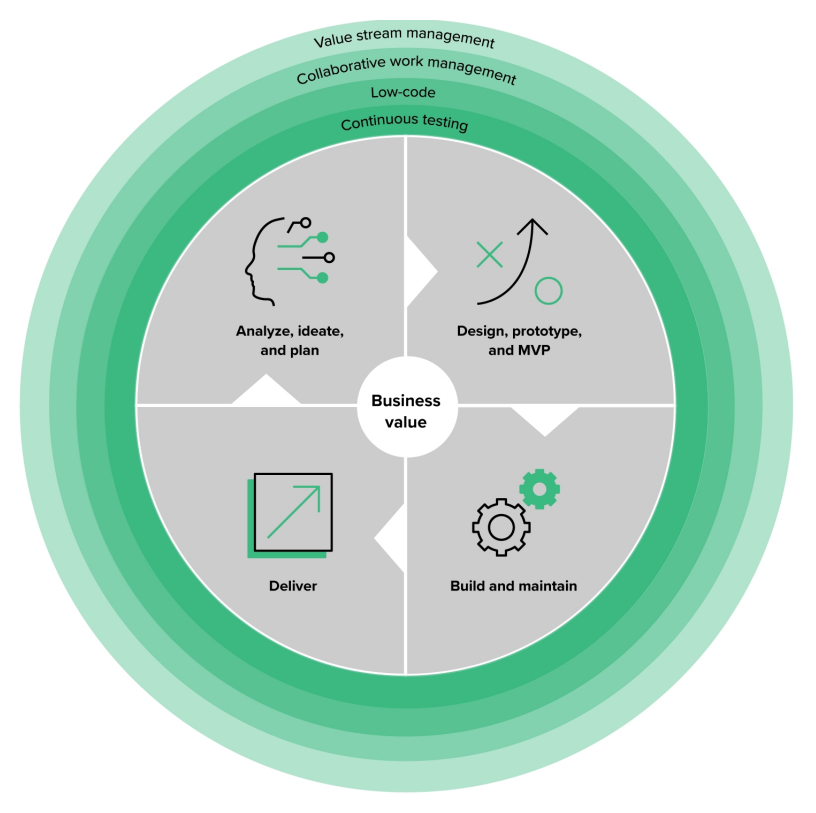Modern Application Development model and Low-Code

Modern Applications to enable innovation in organizations
Modern applications[1] give to organizations the freedom to innovate from a technological and operational point of view, they are cloud-native and have six common features[2] :
- Cloud infrastructure
- Modern design
- Microservices
- Containers
- Backing services
- Automation
Modern applications are scalable, open to integrations and are developed rapidly, on the opposite of monolithic isolated legacy applications, which prevent organizations to change and stay at the pace of market and customer needs evolution.
These kind of applications are today developed with agile tools and methodologies[3], since the relationship between people, the working applications at any stage, the customer engagement and the fast response to change are critical components to realize the right applications in the right time for the right people. Realizing applications having these goals means to focus the development on business value and not on technology value.
The Modern Application Development (MAD) model is focused on business value
The business value is the core of the MAD model proposed by Forrester[4] to replace the traditional software development lifecycle since, as Diego Lo Giudice (VP, Principal Analyst at Forrester) states “There are no doubts that agile has had a ripple effect on many of the software development lifecycle (SDLC) components: from a renewed relationship between development teams and application/product business stakeholders, to the way that agile encourages and enforces MVP requirements, to the way testing has become a modern practice of continuous testing, to replacing all repetitive manual steps throughout the SDLC with automation everywhere, all the way through to deployment — this has all led to a revolution of development. ALM is dead — long live MAD: modern application development.”[5]
The Forrester MAD Model is thought to improve software development and delivery by focusing on 4 key central tasks and 4 differentiators that are around the core (figure 1).

Figure 1 - The Forrester Modern Application Development model - Source: Forrester Research, Inc.
The core is the business value, since it is the principal goal and it is created accomplishing the four central activities that form for the development cycle:
- Analyze, ideate, and plan
Since business point of view is the core and value the goal, every development should start with analyze, ideate and plan, as done at the beginning of every business project, also taking in consideration business and not only technological KPI.
- Design, prototype, and MVP
Cloud-native technologies and rapid application development let create MVP in zero time, in order to experiment and engage all the stakeholders.
- Build and maintain
This phase has to be highly automated, also with the usage of Low-Code platforms, which let build software in real time and evolve it easily.
- Deliver
Also delivery is automated, to provide continuous deployment and integrations and ensure application consistency.
Low-Code differentiates development speed of mature organizations from the rest
In the MAD model there are four external loops around the four central activities that represent value-added activities that differentiate mature organizations from the rest.
Low-Code development is the component in the model which enables the development speed required by the MAD model. More mature organizations that adopt the MAD model are using Low-Code platforms to focus application development on business value. Low-Code, in fact, is increasingly used for core applications development, but is also useful to rapidly develop all the applications required by business needs that have not been realized before the usage of this technology, because of the lack of time and resources.
Business value and speed are therefore the two levers on which every company has to focus on, in order to serve the markets with the best solutions in the minimum time and to provide modern applications ready for every future business scenario.
Explore all the benefits of Low-Code development >
Sources
[1] https://www.techtarget.com/searchcio/feature/The-rise-of-modern-applications-Why-you-need-them
[2] https://riduncan.medium.com/modern-application-development-88588e67d761
[4] Forrester Research, Supercharge Your Development Transformation With The Forrester MAD Model, August 2, 2021
[5] Forrester blogs, MAD Services — The Best Of The Best, August 10, 2022, (Diego Lo Giudice)
Latest Stories
Vibe Modeling: where AI meets Low-Code
From Cost Control to Continuous Innovation: The CIO’s New Balance
CIO priority for 2026: boosting productivity, including Low-Code
Tag
AllArtificial Intelligence - AI
BPA Development
BPM Software
Customer
Digital Transformation
Distribution & Retail
Energy & Utilities
Enterprise Applications
Finance & Insurance
IoT
LinkedIn Live
Low-code
Manufacturing
Mobile Development
Modernization
Partner
Shadow IT
Travel & Transportation
Web Development
WebRatio Platform